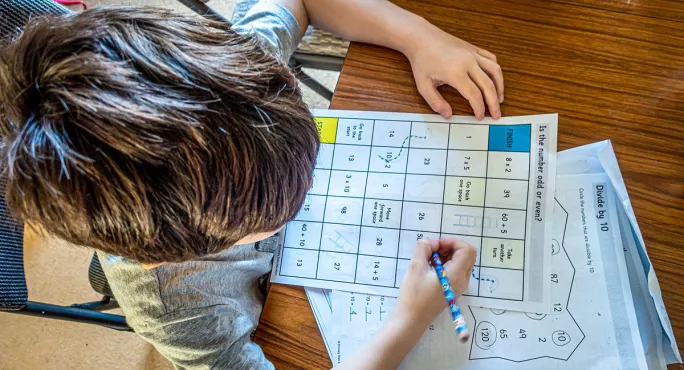Poorer pupils still behind on maths and reading after Covid

Disadvantaged primary and secondary pupils are still further behind their peers in maths than they were before the pandemic, a report from the Education Policy Institute (EPI) and Renaissance reveals.
The research shows the disadvantage gap has widened, from 6.9 months to 8.7 months, in primary pupils’ maths progress compared with before the pandemic.
The report also reveals that secondary students from disadvantaged backgrounds’ reading levels “have not recovered from the pandemic”.
Headteachers’ leaders said the findings increase frustrations that the government “failed to provide sufficient investment in education recovery”, adding that it is “abundantly clear that there needs to be continued investment”.
- Background: Poorer pupils extra month behind in maths
- NFER: Pandemic catch-up must focus on those in need
- Exclusive: Warning over primary catch-up ‘ticking time bomb’
Experts have increasingly sounded the alarm over the widening disadvantage gap amid concerns about rising costs and increasing strain on public services.
Leaders warned last year that the disadvantage gap is “heading squarely in the wrong direction” after reaching its widest point since 2011.
Today’s analysis finds that progress has slowed in secondary mathematics for both disadvantaged and non-disadvantaged pupils since the start of the pandemic.
However, unlike in primary, the disadvantage gap for maths narrowed slightly in secondary in 2022-23, from 17.7 months to 15.9 months, owing to a slight improvement in disadvantaged students’ results.
Despite this improvement, disadvantaged pupils’ attainment in secondary maths is still below levels achieved before Covid.
The analysis is based on outcomes for pupils in Years 3 to 9 and is drawn from more than six million assessments in Renaissance’s Star Reading and Star Maths, from the 2017-18 to 2022-23 academic years.
The report defines disadvantaged pupils as those who have been known to be eligible for free school meals (FSM) at any point in the previous six years.
Proportion of ‘persistently disadvantaged’ pupils rises
The analysis also looked at the impact the pandemic had on “persistently disadvantaged” pupils - those who have been eligible for FSM for at least 80 per cent of their time in school.
The proportion of primary-aged pupils classified as persistently disadvantaged increased from 8.9 per cent before the pandemic to 13.3 per cent in 2022-23.
And the proportion of secondary-aged pupils classified as persistently disadvantaged increased from 9.1 per cent before the pandemic to 10.6 per cent in 2022-23.
Analysis found that the pupils falling in this bracket “have particularly low outcomes when compared with non-disadvantaged pupils and those who are disadvantaged for a relatively short period of time”.
In primary mathematics, for example, all disadvantaged groups saw falls in attainment during the pandemic.
However, the disadvantage gap for persistently disadvantaged pupils was nearly double that for low persistence disadvantage (10.1 months for persistently disadvantaged pupils compared with 5.3 months for low persistence disadvantaged pupils).
Secondary students’ reading has not recovered after Covid
While overall attainment in primary reading is slightly higher than pre-pandemic levels, the analysis shows that this improvement has been driven by the rising attainment of non-disadvantaged pupils.
Attainment in reading for primary-aged pupils from non-disadvantaged backgrounds increased by about 1.2 months of additional learning in that period, according to the report.
However, the report highlights that the fall in attainment for pupils from disadvantaged backgrounds is equivalent to about 0.7 months in lost learning, with the overall disadvantage gap growing to almost two months wider than it was before the pandemic (an increase from 10.8 months to 12.7 months).
Despite this, the report does highlight that results for pupils from disadvantaged backgrounds have recovered slightly from their lowest point in the pandemic.
Meanwhile, the report reveals that results for reading for disadvantaged secondary students from disadvantaged backgrounds “have not recovered from the pandemic”.
It adds that the widening disadvantage gap in secondary reading has been driven by falling attainment for poorer pupils while attainment for their non-disadvantaged peers has remained “largely unchanged”.
Overall, the disadvantage gap is 2.4 months wider than it was before the pandemic (an increase from 18.8 months to 21.2 months).
Schools have ‘moved heaven and earth’ to support pupils
Geoff Barton, general secretary of the Association of School and College Leaders, said that schools have “moved heaven and earth to support children in catching up with lost learning from the pandemic”.
“This analysis makes it even more frustrating that the government not only failed to provide sufficient investment in education recovery in the first place but is now pulling the plug on the national tutoring programme - which was its flagship recovery programme,” Mr Barton said.
He added: “It is abundantly clear that there needs to be continued investment in education recovery and there is a strong case for continued investment in a tutoring programme as a permanent feature of the education system, as a means of narrowing the attainment gap between disadvantaged pupils and their peers.”
Jon Andrews, head of analysis and director for school performance and systems at EPI, said that the report “shines further light on the disproportionate impact that the Covid-19 pandemic had on the outcomes of disadvantaged pupils, worsening already stark inequalities”.
And he warned: “These inequalities should be a significant concern for policymakers and education providers.”
For the latest education news and analysis delivered directly to your inbox every weekday morning, sign up to the Tes Daily newsletter
You need a Tes subscription to read this article
Subscribe now to read this article and get other subscriber-only content:
- Unlimited access to all Tes magazine content
- Exclusive subscriber-only stories
- Award-winning email newsletters
Already a subscriber? Log in
You need a subscription to read this article
Subscribe now to read this article and get other subscriber-only content, including:
- Unlimited access to all Tes magazine content
- Exclusive subscriber-only stories
- Award-winning email newsletters
topics in this article



